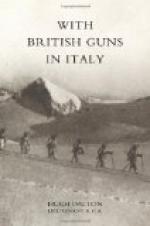The Arditi, or Assault Detachments, correspond to the German Sturmtruppen. They were instituted in the Italian Army in 1917. They also consist of picked men, and undergo a special training to accustom them to bomb-throwing at close quarters and to other incidents of the assault. In the course of this training casualties often occur. Only young unmarried men of exceptionally good physique can become Arditi. They are only used in actual attacks and never for the purpose of merely holding trenches. They therefore spend a large part of their time behind the lines and receive, I believe, extra pay and rations. They are armed with rifles and pugnali, or small daggers, and wear a low-cut tunic, with a black knottie and a black fez. On each lapel of their tunic they wear two black flames, similar to the crimson flames on the collars of the Bersaglieri. They are, therefore, known as “fiamme nere,” or black flames.
A large proportion of Arditi are Sicilians, and their fighting quality is very high. Certain detachments of Bersaglieri are also classified as Assault Detachments and wear low-cut tunics like the Arditi.
The Italian Mountain and Field Artillery are excellent; their Heavy Artillery is handicapped, in comparison with ours, by its smaller ammunition supply and fewer opportunities for prolonged practice, but its methods are scientific and its personnel very keen and capable. The Italian Engineers have done much wonderful work, to which I shall refer later.
CHAPTER IV
THE WAR ON THE ISONZO FRONT
From Monte Nero to the Adriatic the distance is, in a straight line, some 35 miles. Allowing for the curves of the actual line, the length of Front is between 40 and 50 miles. This portion of the Italian and Austrian lines is commonly spoken of as the Isonzo Front. It is not like the Front in the higher Alps, where, as on the Adamello, trenches are cut in the solid ice, where the firing of a single gun may precipitate an avalanche, where more Italians are killed by avalanches than by Austrians, where guns have to be dragged up precipices and perched on ledges fit only, one might think, for an eagle’s nest, where food, ammunition, reinforcements, wounded and sick have all to travel in small cages attached to wire ropes, slung from peak to peak above sheer drops of many thousand feet, where sentries have to stand rigidly stationary, so as to remain invisible, and have to be changed every ten minutes owing to the intense cold, where Battalions of Alpini charge down snow slopes on skis at the rate of thirty miles an hour, where refraction and the deceiving glare of the snow make accurate rifle fire impossible even for crack shots,—the Isonzo Front is not so astounding and impossible a Front as this, but it is yet a very different Front from any on which British troops are elsewhere fighting in this war.




